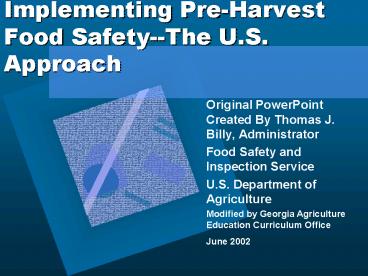Implementing PreHarvest Food SafetyThe U'S' Approach - PowerPoint PPT Presentation
1 / 13
Title:
Implementing PreHarvest Food SafetyThe U'S' Approach
Description:
Implementing Pre-Harvest Food Safety--The U.S. Approach ... 'We must bring producers into the food safety business in order for the farm-to ... – PowerPoint PPT presentation
Number of Views:34
Avg rating:3.0/5.0
Title: Implementing PreHarvest Food SafetyThe U'S' Approach
1
Implementing Pre-Harvest Food Safety--The U.S.
Approach
- Original PowerPoint Created By Thomas J. Billy,
Administrator - Food Safety and Inspection Service
- U.S. Department of Agriculture
Modified by Georgia Agriculture Education
Curriculum Office June 2002
2
Challenges to Pre-Harvest Food Safety
- Limited information on effective practices
- National governments have limited authority
- Numerous variables exist, such as farm practices,
animal health, and the environment
3
U.S. Farm-to-Table Strategy
- Those in control of each segment must bear the
responsibility for identifying and preventing or
reducing food safety hazards.
4
Pathogen Reduction/HACCP Rule
- Cornerstone of strategy
- HACCP, performance standards for Salmonella,
testing for generic E. coli, sanitation SOPs - Ripple effect to pre-harvest level
- Results reduced Salmonella on products reduced
human illnesses
5
Factors Driving Pre-harvest Change
- Regulatory requirements
- HACCP rule
- E. coli O157H7
- FDA feed ban
- Marketplace demands
- McDonalds Corp.
- Consumers
6
Third-Party Certification Programs
- Demand growing, e.g. MinnCERT
- Assure purchasers that certain practices have
been followed - Non-Hormone Treated Cattle Program
7
FSIS Pre-Harvest Strategy
- No regulatory authority at pre-harvest
- Educate producers
- Research
- Farm-to-table risk assessments
- One size doesnt fit all
- Transparency critical
8
Educating Producers
- Use existing infrastructure to communicate
- Partnerships with state animal health agencies
- Commodity-specific programs such as Trichina-safe
pork certification - Guidelines for producers
- Producer organizations play role
9
Research
- More research needed to identify specific
practices to reduce hazards - Multiple intervention strategies needed
- Promising interventions include competitive
exclusion, feed and water additives - Decoded genome for E. coli O157H7 may lead to a
vaccine
10
Farm-to-Table Risk Assessments
- Salmonella Enteritidis
- Led to Egg Safety Action Plan
- Farm-to-table interventions being implemented by
various agencies - FSIS Risk Assessment Center
11
Future Plans
- Build on current activities
- Increased role for veterinarians at pre-harvest
level - education
- disease traceback
- residue avoidance
12
Recommendations
- New requirements for meat and poultry plants
should have a ripple effect on production sector - Partnerships critical
- Science, through risk assessment, is key to
developing effective risk reduction strategies
13
GoalWe must bring producers into the food
safety business in order for the farm-to-table
chain to stay connected and be effective.

